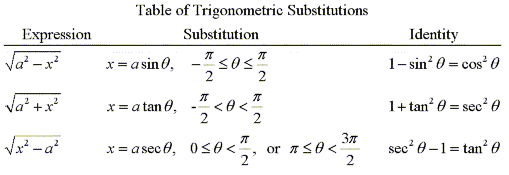Sometimes trigonometric substitutions are very effective even when at first it may not be so clear why such a substitution be made. For example, when finding the area of a circle or an ellipse you may have to find an integral of the form  where a>0.
where a>0.
 where a>0.
where a>0.
It is difficult to make a substitution where the new variable is a function of the old one, (for example, had we made the substitution u = a2 - x2, then du= -2xdx, and we are unable to cancel out the -2x.) So we must consider a change in variables where the old variable is a function of the new one. This is where trigonometric identities are put to use. Suppose we change the variable from x to  by making the substitution x = a sin θ. Then using the trig identity
by making the substitution x = a sin θ. Then using the trig identity  we can simplify the integral by eliminating the root sign.
we can simplify the integral by eliminating the root sign.
 by making the substitution x = a sin θ. Then using the trig identity
by making the substitution x = a sin θ. Then using the trig identity  we can simplify the integral by eliminating the root sign.
we can simplify the integral by eliminating the root sign.
By changing x to a function with a different variable we are essentially using the The Substitution Rule in reverse. If x=g(t) then by restricting the boundaries on g we can assure that g has an inverse function; that is, g is one-to-one. In the example above we would require  to assure
to assure  has an inverse function.
has an inverse function.
 to assure
to assure  has an inverse function.
has an inverse function.
If we look at the Substitution Rule and replace u with x and x with t, we obtain

This is known as the "inverse substitution".

댓글 없음:
댓글 쓰기